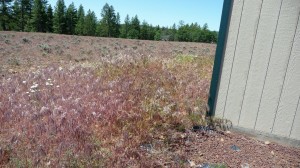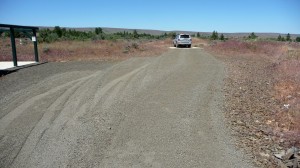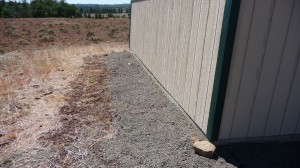I recently returned from a busy 4th of July weekend at Zephyr Ridge Observatory. It was a mission that combined astronomy and property maintenance. In this post I will describe the maintenance, and I will follow with a detailed observing report once I finish compiling my logs.
When last I visited Zephyr Ridge Observatory (in early June), I noticed that native grasses and other plants were beginning to flourish, and some of these were encroaching onto my driveway and next to the building. On this trip, I came prepared with a simple weed whacker (hand tool) and expected to spend a little time tidying up before receiving a delivery of gravel that I had arranged.
I was quite surprised at the sight that greeted me when I arrived on July 1. My driveway and parking circle were overwhelmed with plant life (mostly grasses – 2 feet tall in most places), and the perimeter of my building was literally under siege by 2-4 foot tall grass and various other plants. I arrived at about noon, and the gravel was scheduled to arrive at 2 PM, so I wasted no time getting to work, clearing as much as I could off of the parking circle to prepare for the gravel. (The parking circle and driveway are covered with base rock, and I ordered a load of ¾- rock to put on top. The plants grew through the rock, taking advantage of any soil space in between.) With hindsight, I should have brought my gas-powered brush cutter rather than the primitive hand tool.
As it happened, my gravel arrived 40 minutes early, but the driver was kind enough to wait while I finished clearing. He dumped a small pile for me to use for the building perimeter, and spread the remainder on the parking circle and a portion of the driveway. A total of 14.3 tons were delivered.
After observing until 3:30 AM, I set to work again by 8:00 AM the next morning, as my friends Jon and Jerry were due to arrive for a visit and I wanted to make headway on the clearing project. I worked steadily until noon, at which point the increasing heat and lack of sleep caught up with me, and I decided to rest. Jon arrived at about 1:30 PM, and he kindly finished whacking the weeds for me, and also contributed some shoveling, carting, and spreading of gravel around the building. (Thank you, Jon!) I placed thick plastic around the building perimeter to provide a water barrier (to solve the concrete issue I mentioned in a previous post) and to thwart further plant growth, and the gravel was spread on top of this barrier.
The foregoing project description is a rather routine matter, to be sure, and is another example of the sort of maintenance required to manage a remote observatory. But there are two insights I would like to share about this experience.
When I first bought this property, I did not fully appreciate the extent and complexity of the plant life there. I am used to the lush greenery of the Seattle area, and my eastern Washington property is comparatively arid. A superficial inspection reveals sage, a few grasses, and lots and lots of rocks. Aside from two groves of trees, the majority of the property seemed rather barren. Wrong! With the benefit of three years experience, I see that the land is filled with life, and I have been able to observe growth and seasonal changes in abundance. I have come to appreciate and respect the plants that grow there. It is remarkable to see how these plants are able to survive and thrive in what appears to me to be very harsh conditions, with extremely rocky soil and very dry summers. The fact that the native species were able to grow where I do not want them is further testimony to their tenacity.
The second insight is that the so-called weed problem is entirely my fault. By hiring an excavator to clear a driveway and dig a space for my observatory, I upset the balance in the areas I disturbed. For example, the soil around the perimeter of my building was redistributed and graded, and is likely a little thicker than it was before my project began. Native grasses have flourished in this area in particular, exemplifying the opportunistic nature of the native species. Looking at the undisturbed land nearby, one can see that the grass is more intermittent, far less virulent than on the disturbed soil. The untouched land seems to have a better balance and harmony among the various species.
I chose to develop a portion of my property by constructing a driveway and a building. I knew that my project would be a violation to an otherwise pristine land, and I worked with the excavator to find ways to minimize the impact as much as possible while still achieving the goal. In the end, my project required a sacrifice of some portion of the native species, but this is counterbalanced by my newfound appreciation for the life that is there and my ability to connect intellectually and spiritually with the cosmos overhead. I think the land has forgiven me for my project, but the intrusive plants are a reminder that it is me who is the intruder.
Denis



